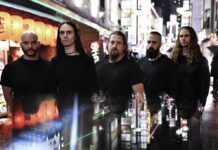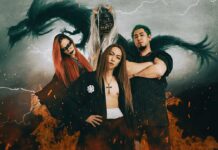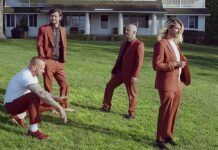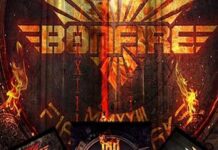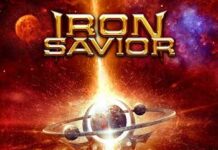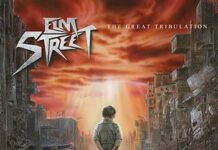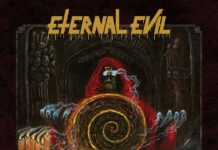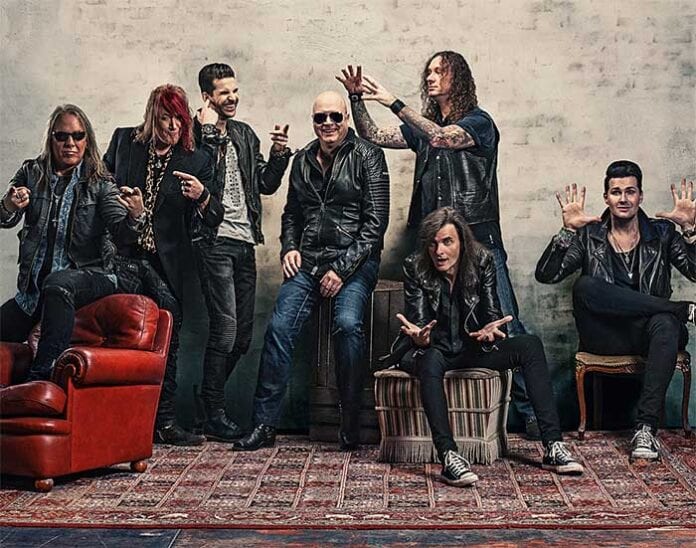
BY GEORGE PACHECO
The date is September 14th, 2018, pre-Covid. I’m standing alongside a group of my closest friends, about to watch one of my favorite bands in the world play a once in a lifetime reunion gig with two lead singers, three guitarists, and a whole lot of expectation.
The band is Helloween, and I’ve been listening to them for over 20 years. Their early origins date back to the late 70s with guitarist Kai Hansen under a number of different guises, before finally recording the self-titled Helloween EP and the Walls of Jericho full-length in 1985. At this point, they were a raw but melodic speed metal outfit with catchy songs, a memorable name, and an arsenal of riffs at their disposal.
Fast-forward a couple of years, and what many consider to be the “classic” Helloween lineup is solidified for the two Keeper of the Seven Keys albums—Kai Hansen and Michael Weikath on guitar, Markus Grosskoph on bass, Ingo Schwictenberg on drums, and Michael Kiske taking over as lead vocalist from Hansen. It’s Kiske’s stratospheric vocals that really caught me when I was a young boy, just as it did legions of other Helloween fans around the world.
Kiske’s approach was pure, powerful, and more melodic than Kai’s sandpaper growl. It fit the more textured and clean sounding attack that the Keepers albums were bringing to the table. If Helloween’s Death Metal demo introduced them to the underground, it was this duo of power/speed metal masterpieces that helped launch them into the semi-mainstream. Of course, a slot on MTV’s Headbanger’s Ball in 1989 didn’t hurt things, either, as Helloween snagged an opening slot alongside Exodus and Anthrax across North America.
It was a few years after this tour that I discovered Helloween, picking up a cassette tape of Keeper of the Seven Keys Pt. II in my travels as a young and hungry metalhead scouring shopping malls and record stores for my next heavy fix. I was already slightly familiar with the band at that point, thanks to hearing “I’m Alive” on a cheap cassette compilation and seeing the video for “Halloween” on MTV. Kiske’s vocals on this particular album spoke to me in a different way, however, a way that I hadn’t felt probably since I first heard Iron Maiden years before. I was a awkward and overweight teenager trying to find my way in a Catholic high school, dealing with the usual bully bullshit that thankfully occurred during a pre-internet era where the 2:30 school bell meant that my torment was at least over for the day.
Still, a lot of the annoyances and stresses of adolescence would often stick themselves to me on the drive home when my parents picked me up and weighed heavy on my mind. My mom and dad realized early on how big of a driving force music and heavy metal was on my life, and they encouraged me to discover and enjoy as much music as I could. They gave me an allowance to pick up more tapes, let me play around with the car radio, and most importantly didn’t get mad at me when I would sing at the top of my lungs to my favorite albums while alone in my room.
One of those albums was the aforementioned Keeper Pt. II. It spoke to me in the way it likely did for so many others, and it served as an escape from what was going on at school. Kiske’s vocals were pure, and I knew every word like it was gospel, playing air guitar to epics like “March of Time,” “I Want Out,” and the 13-plus minute title track, “Keeper of the Seven Keys.” I would pretend I was assisting the Seer of Visions in his quest to lock up the seven seas and save the world from demons and disease, and I truly embodied that clichéd adage as I “sang like nobody was watching.” It was escapism at its finest, the sort of thing that many of those outside the world of heavy metal might scoff at as kiddie Dungeons & Dragons and stuff, but I didn’t care. Listening to Helloween meant everything to me during a time when it felt like nothing was going right.
The thing is, I wasn’t alone in feeling this way. At least, I don’t think so. In a world where so many of Helloween’s peers, be they Scanner or Rage, still mainly dwell within the hearts of true underground fans, the Pumpkins still stood united in 2018. Why is that? What has kept Helloween so relevant? Well, for starters, they didn’t rest on their laurels after the Headbanger’s Ball tour, although they did change their stylistic direction a bit. Kiske’s wide array of influences meant that pure heavy metal was going to make way for rock and pop influences, resulting in a pair of full-lengths that left some fans divided—1991’s Pink Bubbles Go Ape and Chameleon in 1993.
Bizarre title aside, Pink Bubbles Go Ape is the more traditional of the two, possessing some legit metal burners, such as “The Chance,” but is a melodic rock record at its heart, with a heavy dose of humor. “Heavy Metal Hamsters” and “Kids of the Century” still kick ass, but we’re definitely a ways away from the rip-roaring days of “Future World” or “A Little Time.” Chameleon is an even more mature record that distances itself even further from Helloween’s old sound, although tracks like opener “First Time” and the beautiful ballad “Windmill” still stand amongst my favorites to this day.
The band would eventually part ways with Kiske after these records, but again, remained in the minds of metal fans with one hell of an energetic reinvention. Helloween would survive the tragic loss of drummer Schwictenberg to suicide, but powered through with former Pink Cream 69 singer Andi Deris to release Master of the Rings in 1994, a stunning and satisfying collection of songs with a definite slant back towards proper heavy metal. The sense of humor that had always fueled Helloween was still there, but this time armed with an bushel of ripping riffs the likes of which hadn’t been heard since the Keepers days. “Sole Survivor,” “Where the Rain Goes,” and “Perfect Gentlemen” shot out of the gate like cannon fire, proving to everyone that Helloween 2.0 was not to be fucked with.
Michael Kiske is my favorite singer of all time, but goddamn if you can’t make a solid case for Andi Deris being just as good, if not better. The man’s voice fit (and continues to fit) the Helloween sound like a glove, especially as the 90s and new millennium ushered in new technology and recording techniques. This new Helloween was determined to march with time and grow right alongside the new breed of power metal bands that were inspired in their wake. This fits lockstep into why Helloween has remained relevant as one of, if not the definitive German power metal band, with this idea of progression and maturity, even if the band’s lyrics were sometimes joyfully goofy. “The Game Is On” was literally written about a GameBoy, after all, and used music from Tetris as its main melody.
It’s important also to note that this new iteration of Helloween was also soldiering on without its founder Kai Hansen, who had departed the band after the Keepers records. If there was any doubt that guitarist and songwriter Roland Grapow was the reason for the softer Helloween present on Pink Bubbles and Chameleon, all of that was silenced with Master of the Rings and its even heavier follow-ups. Indeed, it’s easy to see the release of Helloween albums Time of the Oath, Better Than Raw, and The Dark Ride as some sort of new renaissance, so powerful and memorable were the tunes contained within.
So, just as Kai Hansen was being creative with his own band Gamma Ray, so too was Helloween enjoying some of the most fruitful periods of existence with these albums. Songs like “Power,” “Steel Tormentor,” “Falling Higher,” and “If I Could Fly” enjoyed prominent slots in the set list, while The Dark Ride in particular was the absolute heaviest Helloween had sounded in years. Oh sure, the band had experimented with thrashier ideas with Kiske in the past—see the absolute barnstorming B-side “Savage” for proof—but The Dark Ride was full modern metal for the masses, down tuned a bit and still as melodic as the band had ever been in the past.
“Hey Lord!” from Better Than Raw was also an example of religious symbolism from Helloween, although it wasn’t the first time spirituality had been a part of the band’s oeuvre. I had the absolute pleasure of interviewing three members of the band at different times over the years—including Kiske for the Unisonic project and Hansen for Gamma Ray—but it was Michael Weikath who joked that he almost didn’t pick up the phone when he heard my fanzine was titled Unhallowed. This was yet another way that Helloween stood out from the often dark and destructive world of heavy metal, whether it was the lunacy of pumpkin artwork everywhere or that aforementioned spirituality referenced in songs like “Save Us” or the 2015 LP My God-Given Right. Even the most hardened, Satanic black or death metaller likely has a soft spot for Helloween, and why not?
Enter 2003, however, and we have yet another new dawn for Helloween, specifically the exit of Grapow after disagreements over the heavier direction explored on The Dark Ride. Grapow would go on to form Masterplan alongside singer Jorn Lande, while Helloween recruited axeman Sascha Gerstner for that year’s WTF titled Rabbit Don’t Come Easy. Full disclosure, I’d be lying to you if I said that I’ve kept up big time after this point. This article isn’t attempting to be some sort of catch-all, but perhaps something more of a personal celebration of the band’s back catalog. Shit, maybe some of you guys can fill me in on what I’ve been missing in the meantime.
Anyways, it was for Rabbit Don’t Come Easy that I interviewed Michael Weikath, and I still stand by the album, years later. There are some legit guitar dynamics (check that Van Halen-isms on “Open Your Life”) as well as epic anthems (“Just a Little Sign”), great ballads (“Don’t Stop Being Crazy”), and all time rippers (“Liar”), while the album just might feature one of Deris’ best vocal performances. I paid some lip service to Keeper of the Seven Keys–The Legacy and Gambling with the Devil (both solid, I say), but after this, I sort of fell off the train. Life happened, I formed a band of my own (The Accursed, we released an album titled Seasons of the Scythe and even covered “I Want Out”) and kept on writing, eventually landing at places like Outburn, Metal Maniacs, and Rue Morgue.
But Helloween never left my side. I kept their music in my heart always, and hoped, alongside so many others, that a reunion of the OG lineup would eventually come to fruition. And that brings us full circle to the Worcester Palladium, which appeared sold out, or at least close to it on that chilly September evening. There was a cross section of generations standing shoulder to shoulder with me rocking out to a set list that was drawn up straight from our dreams, with nary a song out of place.
At this point, I’m a married man with a young son of my own. Hopefully, he likes Helloween someday, but I hope he doesn’t come to it under the same circumstances. I doubt he’ll remember me singing “Where the Rain Goes” to him while walking in his stroller, but I can’t help but look at all of the faces, young and old, around me as I watch Hansen, Weikath, Grosskoph, Deris, Gerstner, and Kiske together with drummer Daniel Löble. I watch them and I see myself. I see fans that grew up with the music of Helloween and were here to celebrate that fact once again with a whole new generation. Sure, we may love Angel Dust or Grave Digger, Running Wild or Rage, but Helloween was something just a bit more special. Long may they reign, for tonight…IT’S HALLOWEEN!






